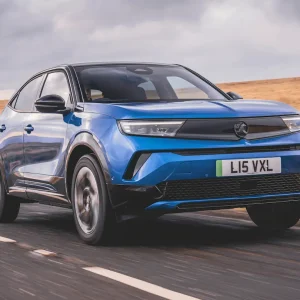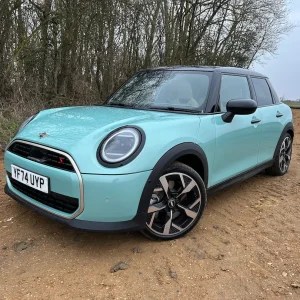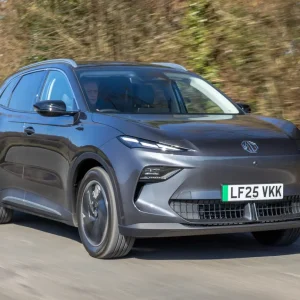Launched in 2017 after the Kodiaq, the Karoq debuted Skoda’s sleek new SUV look. It was the opposite to the quirky but likable Yeti that it replaced, and was far more conventional looking. That was almost five-years ago, and not that long after its big brother the Kodiaq, the Karoq has now received its mid-life facelift.
The biggest changes to Skoda’s mid-size SUV are on the outside. At the front, the Karoq gets the updated, more horizontal family grille, slimmer and sharper LED front and rear lights, plus revised front and rear bumpers. All these updates result in a 9% improvement in aerodynamics, achieving a Cd of 0.30. Other less obvious aerodynamic changes include new alloy wheels with aero inserts and a longer rear spoiler.
Inside, the interior changes for the Karoq are less obvious as they are made up of new trim and chrome highlights, plus the unusual two-spoke multi-function steering wheel that debuted on the more recent Octavia range, which launched back in 2020. The fact it hasn’t changed much isn’t an issue, as interior quality was already excellent and space was impressive. The standard front seats themselves offer a decent amount of support, the driving position is comfortable and there’s also a practical 521-litre boot.
However, despite the facelift, with actual physical dials and an infotainment system from a couple of generations back, you could say it feels dated when compared with other Volkswagen Group models. That said, in our opinion, both the dials and infotainment are better and easier to use than their more modern versions. Shame then that Skoda tell us the digital dials will be standard again from the end of this year when the chip shortage eases.
As we said at the start, SE Drive is the entry-level equipment grade, although there are now only three equipment grades available for the UK market – the others being the SEL and Sportline – which as the badge suggests looks sportier. Still, this Karoq is well-equipped with welcome dual-zone climate control, cruise control, sat-nav, plus automatic lights and wipers. That dual-zone climate control is worthy of particular mention, as we had this car on test during the extreme heat period in July, and we’re pleased to say the interior stayed ice cool on a 300-mile round trip to Worcestershire.
The Karoq has always been a particularly safe choice, with a historic five-star Euro NCAP rating and standard equipment, including a driver fatigue sensor and pedestrian monitor.
On the road, even though the 1.0-litre TSI 110 fitted to our test car might have been the entry-level petrol engine, it picks up from well down the rev range and the 110hp doesn’t feel over worked when we hit the motorway either. The 1.0-litre TSI is reasonably quiet, too – unless when accelerating hard. It is well-matched to the slick six-speed manual transmission here, too – although we found you do have to make more gearchanges than you might expect around town because it is so willing. If the 1.0-litre TSI engine doesn’t work for you, there are a decent selection of diesel and petrol engines.
The 17in wheels and new “Scutus” alloys with their aero inserts might look a bit lost under this Skoda’s arches, but it means this Skoda rides comfortably and confidently whether it’s on motorways or back roads. Tidy and comfortable best sums up the handling, there is some body roll, but the Karoq still feels agile. The biggest problems for this facelifted Karoq, is that despite its competency in many areas, the Skoda doesn’t stand out against the opposition. Plus, even with the improved aerodynamics, in 1.0TSI SE Drive manual form, the CO2 figure is still 132g/km and it attracts a 31% BIK figure. It is hard to improve on this, too, as unlike rivals such as the latest Kia Sportage, the Karoq isn’t available as a mild hybrid or plug-in hybrid drivetrains. However, Skoda’s next three electric cars will be smaller than the Enyaq, or so we are told, so there will be some sort of iV electric alternative eventually.
The facelifted Karoq carries on from the success of the original model. It looks even sharper, has a comfortable, well-made, and spacious interior and is good to drive. However, its lack of a hybrid version could see buyers looking for lower company car tax rated rivals elsewhere.
Skoda Karoq 1.0 TSi SE Drive
P11D: £25,970
Residual value: 50.05%
Depreciation: £12,999
Fuel: £9,157
Service, maintenance and repair: £1,920
Cost per mile: 40.12p
Fuel consumption: 48.7mpg
CO2 (BIK %): 132g/km (31%)
BIK 20/40% a month: £134/£268
Luggage capacity: 521 litres
Engine size/power: 999cc/110hp





